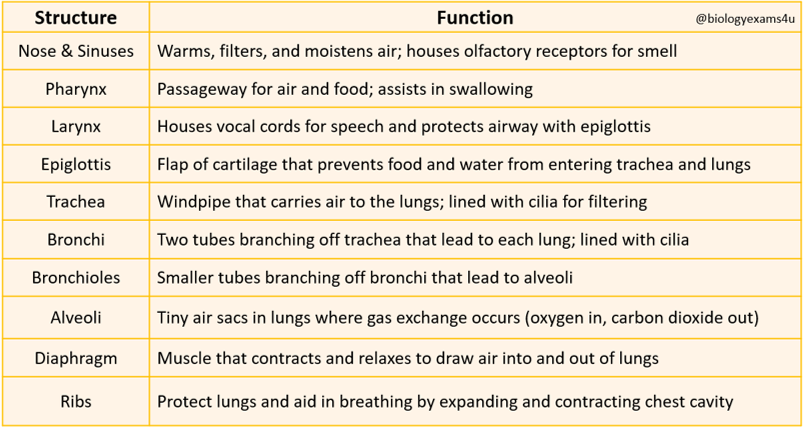What is Respiratory system?
The respiratory system
is the network of organs and tissues that help in breathing or exchange of
oxygen and carbon dioxide (gas exchange). Breathing involved two processes;
Inhalation, the act of breathing in oxygen and exhalation, the act of breathing
out carbon dioxide.
- The upper respiratory tract that include Nose, Nasal cavity, Mouth, Sinuses, Throat (pharynx), Voice box (Larynx), Windpipe (trachea)
- The lower respiratory tract includes lungs, large airways (bronchi), small airways (bronchioles), air sacs (alveoli)
- Nostril: One of the two openings in our nose through which air moves when we breathe and smell.
- Nasal cavity: The nasal cavity is lined with mucous membrane warms and humidifies the inspired air, removes and traps pathogens and particulate matter from the inspired air, responsible for sense of smell, drains and clears the paranasal sinuses and lacrimal ducts.
- Oral cavity: is a pathway for air intake and exhalation other than nose
- Throat (pharynx): muscular tube that connects the nasal cavities to the larynx and esophagus. It is common to both the alimentary and the respiratory tract.
- The epiglottis is flap
of cartilage located in the throat behind the tongue and in front of the
larynx. It prevents food and water from entering the trachea
and the lungs. It stays open during breathing, allowing air into the larynx.
- Voice box (Larynx): A hollow tube of about 4 to 5 cm in length and width through which air pass from throat to trachea on the way to your lungs. It also contains the vocal cords and functions as a voice box for producing sounds or phonation.
- Windpipe (trachea): is a cartilaginous
tube that carries air in and out of the lungs, from the larynx to the bronchi. It
serves as passage for air, moistens and warms it while it passes into the
lungs, and protects the respiratory surface from an accumulation of foreign
particles. The mucus traps dust
particles and other debris before they reach the lung. The cilia in the inner
tracheal layer function to propel the dust away from the lung.
- Bronchi (large airways):
two large tubes that carry air from the
windpipe (trachea) into the lungs and back out again. The main bronchus
splits into primary, secondary and tertiary bronchus.
- Bronchioles (Small airways): smallest airways in our lungs. Final air conductors, that lack cartilage altogether
- Alveoli (air sacs): microscopic balloon-shaped structures located at the end of the respiratory tree. They expand during inhalation, taking in oxygen, and shrink during exhalation, expelling carbon dioxide. These tiny air sacs are the site where gas exchange between inspired air and the blood takes place.
Lungs: lungs are the pair of spongy, pinkish-gray organs in our chest. When you inhale (breathe in), air enters your lungs, and oxygen from that air moves to your blood. At the same time, carbon dioxide, a waste gas, moves from your blood to the lungs and is exhaled (breathed out).
The right and left lung anatomy are similar but asymmetrical. The right lung consists of three lobes: the right upper lobe (RUL), the right middle lobe (RML), and the right lower lobe (RLL). The left lung consists of two lobes: the left upper lobe (LUL) and the left lower lobe (LLL). The left lung is slightly smaller and has a notch to give room for the heart called as cardiac notch.
Visit our TPT store by clicking here.
- Download free resources or purchase worksheets on Respiratory system.
- Please rate the product and follow us on store.

